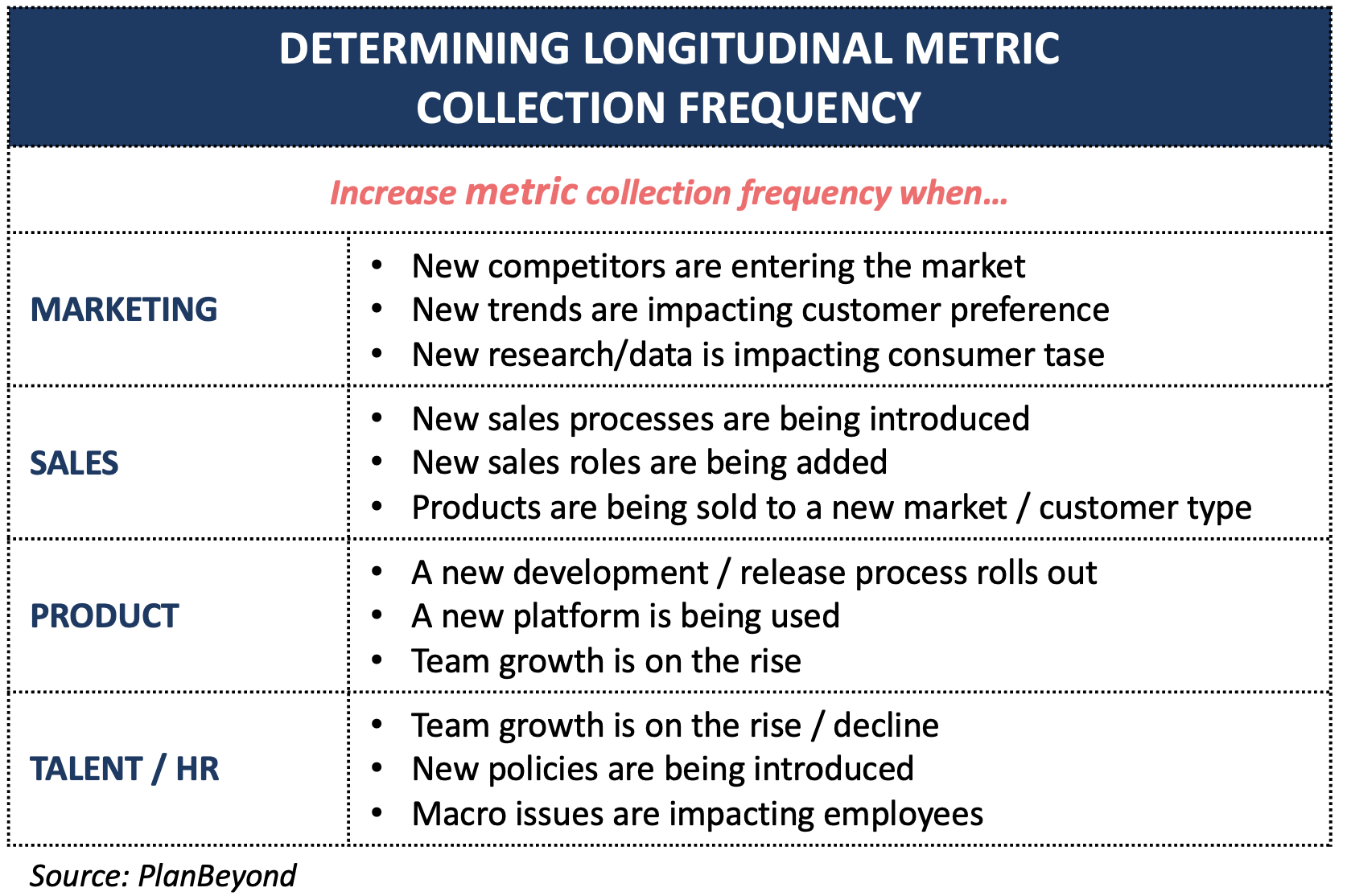Working on hunches is problematic. A single event like a particularly bad customer review or the launch of a long-awaited product can skew perception. The world may appear rosy when problems are actually lurking. Or, the sky may seem like it’s falling…when it really, really isn’t.
How do you instead get an objective view of your business reality? By tracking key data points over time.
Called longitudinal metrics, these data points let you “read” high-level business health across key functional areas quickly. You efficiently isolate what’s really a problem while keeping distractions at a minimum.
What Is A Longitudinal Metric
Longitudinal metrics are data points collected over a long period of time using the same series of questions or data points with the same type of respondents. They are crucial check-in points to identify both positive and negative trends, giving organizations a chance to adjust their activities to stay on the right track of customer and market needs.
These metrics span all key functional areas in your organization, from marketing and sales to product and talent / human resources. And, they vary depending on the functional area of interest (more on that soon!).
There is no hard and fast rule about how frequently you should collect your longitudinal data. Bi-monthly, monthly, and quarterly are all common frequencies in business settings. We suggest letting organizational and environmental factors guide the timing.
But, whatever cadence you do choose, avoid doing this just once per year. We can’t imagine waiting a whole 365 days to measure anything. Too many changes in customer preferences, operations approaches, and competitive landscapes will take hold. Keep to shorter measurement intervals to stay ahead of issues.

Key Longitudinal Metrics Across Functional Areas
Now that you have the gist of what longitudinal metrics are, let’s look at the types of metrics you should care about.
We suggest thinking about them in the context of key functional areas in any business or organization. As overarching metrics that govern daily activities, select metrics that represent key performance indictors in those areas. By keeping an eye on them, team members will see if certain activities are helping the business move in the right direction or not.
Longitudinal Marketing Metrics
There are a host of different metrics we could look at within the marketing realm. However, if you have to limit it, we suggest brand awareness and brand trust.
- Brand Awareness: Brand awareness measure how many relevant types of people are aware of your brand. This can be unaided awareness, which measures if your brand name is on the tip of anyone’s tongue. Or, aided awareness, a measure of peoples’ ability to recognize your brand name.
- Brand Trust: Brand trust takes awareness one step further by determining if your brand stands for something positive in customers’ minds. People can hold positive, negative, or neutral trust in a brand.
Why did we select these two as the longitudinal marketing metrics to track? Because awareness is a leading indicator of getting new customers over time. After all, it’s hard to try a product if you don’t know it exists. Meanwhile, trust determines whether there is positive sentiment about your brand. This determines if word of mouth and referrals are on the horizon.
Longitudinal Sales Metrics
Key sales metrics often vary based on the type of organization you’re in. Some organizations have people-heavy sales processes. Others don’t. Below are a few options that tend to apply regardless of organization type.
- Close Rate: Close rates measure how effective sales teams are. This could be the trial-to-customer conversion rate. Or, maybe it’s proposal-to-customer conversion rate.
- Average Order Revenue: This measures how much money you bring in from each new customer or order you close.
We like these metrics because they show how effective the team is at getting truly relevant, qualified prospects to the finish line. Further, they indicate if the types of prospects getting to the finish line are financially worth the effort.
Longitudinal Product Metrics
Product metrics are often unique to the actual product itself. What’s relevant for a software product is likely very different than what’s relevant for a consumer hard goods product. As a result, we suggest sticking to two fairly universal metrics:
- Rate of Complaints: The rate of complaints is a percentage of how many complaints you receive relative to orders or customers in a given span of time.
- Rate of Returns: Return rate looks at how frequently people ask for refunds or replacements. You could also use cancellation rate instead if you’re a technology or subscription services company.
These two longitudinal product metrics get to the essence of customer satisfaction. As a result, they serve as strong proxies for product satisfaction and therefore long-term customer retention.
Longitudinal Human Resource / Talent Acquisition Metrics
Talent management also features a wide number of metrics to track. Let’s limit it to the two we know just about everyone should care about:
- Employee Retention Rate: This is defined as the percentage of employees that stay with your organization over a fixed span of time.
- Employee Value / Recognition: This is a measure of how valued or recognized employees feel on the job. You can choose to measure it on a 5-point or 10-point scale. The more sensitive you want to be to changes in sentiment, the more you should use a 10-point scale.
Why these two metrics? Retention rate is an easy one. You can’t get work done, let alone high-quality work, if valuable team members are quitting.
Meanwhile, value and recognition is a strong leading indicator of retention. An incredible amount of research shows high correlations between feeling valued on the job and sticking around. This is because lack of salary or professional growth as well as poor supervisor interactions feed into this number. If you see employees feeling undervalued, you’ll likely see higher attrition in the future.
How To Respond To Changes In Longitudinal Metrics
Unless you’re in a hyper-static category, any longitudinal metric you track will change over time. The better thing to consider as you track those metrics is what increases or decreases mean.
For instance, we generally think that high sales close rates are good. But, they could be a sign of a company being too conservative. Not entering new markets and not trying to work with different types of prospects will yield great numbers…but not necessarily long-term growth or viability.
As your organization goes through transitions, keep an eye on those metrics. Trying new things may bring certain numbers down…but that might be okay. Meanwhile, certain organizational initiatives may be about driving these numbers up. If you don’t see improvements over a period of time, you have an objective sign that you need to revise your process.
Keep in mind that tracking longitudinal metrics is all about avoiding knee-jerk reactions. The process of consistently collecting and tracking these numbers gives you the jump you need on issues before panic sets in.





